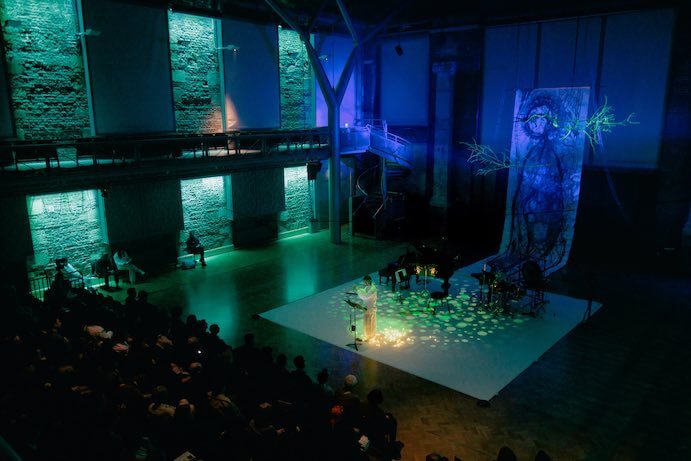Tangram, a collective of musicians who celebrate the interaction between contemporary Western and Chinese musics, marked their fifth anniversary on 27 Jan. at LSO St Luke’s. But rather than being a celebratory programme, like their 2022 Lunar New Year concert, this event had a more contemplative feel. In the words of their flautist Daniel Shao, who curated the programme, it represented ‘a journey navigating the fragile relationship between humans and our environment through sound, installation, and performance art.’ Contributing to this immersive experience was a huge vertical painting by art director Echo Morgan, which formed a backdrop that oddly seemed to shapeshift in different lighting.
Dai Fujikura’s short cello piece Hidden Tree opened the concert in elegiac mood. Composed during lockdown, the piece is inspired by the organic growth of trees and the dark wood of the instrument, and Garwyn Linnell’s poised performance provided space for reflection.
Tangram presents “Nature Echo” at LSO St Luke’s — Photo by Mike Skelton
Many of the strongest works on the programme were by young composers, including Zhenyan Li’s Bamboo Echoes for dizi (Chinese bamboo flute, played by Shao), cello (Linnell), percussion (Beibei Wang) and piano (Annie Yim). Li, who herself plays the dizi, is from the southern Chinese province of Sichuan, which is famed for the quality of its bamboo; the organic growth of the plant fascinates her, as does its frequent evocation in Chinese literature. The quartet showcased Li’s imaginative ear for timbre and sense of drama. There were moments when the whole ensemble seemed to be infused with the bamboo flute’s slippery glissandi.
Plastic Ceremony by Tangram co-director Alex Ho was performed by Beibei Wang, one of the most extraordinary percussionists on the London scene. This was an imaginative lament with a ritualistic character. Opening with Wang agitating a pair of percussion beaters wrapped in plastic, she drew a huge variety of sounds from a single Chinese drum, 16 plastic bags, a couple of beaters, and vocalisations. She is a powerfully theatrical performer who compels attention, as also shown in Electra Perivolaris’ Sleeping Warrior for flute and percussion. Composed for Shao and Wang, the piece was inspired by the mountain contours of Scotland and Greece. While the musical material was slight, Shao’s uncanny blending of vocal utterance and the flute, combined with Wang’s mesmerising control of a pair of stones, created a striking impression.
Tangram presents “Nature Echo” at LSO St Luke’s — Photo by Mike Skelton
During the interval, venue staff positioned a table centre stage for Vivian Fung’s The Ice is Talking for percussionist, ice, and electronics. The piece was commissioned by the Banff Centre in Canada: Fung’s childhood memories of vacations in the Canadian Rockies, and her realisation that the icecap has receded, were the starting point for the work. Tapping, brushing, and scraping the ice blocks with a couple of table knives, Wang created an unforgettable spectacle, against the aural background of an ever-mobile electronic soundscape that sounded like distant, underwater resonance. Wang added amplified vocalisations, concluding in a whisper with the only understandable phrase: “the ice is talking.”
As Shao approached the performance area for Liza Lim’s Bioluminescence, art director Echo Morgan appeared and threw handfuls of tiny lights around his feet: you don’t often hear a London audience gasp, but they audibly responded to the surprise beauty of the lights. According to Shao, the piece was ‘inspired by squid that have twinkly lights inside them,’ and he made the fiendishly complex multiphonics and tremolandi sound as if the music was swimming in space.
Tangram presents “Nature Echo” at LSO St Luke’s — Photo by Mike Skelton
Sun Keting’s short piece for cello and piano, before we were ocean, was more harmonically-driven than other works on the programme. Yim’s piano chords formed the ground underneath Linnell’s ethereal cello lines, though they moved closer together in the more vigorous central section. The piece’s poignant lyricism acted as a welcome contrast to the lively virtuosity of much of the rest of the programme.
We had more surprises in store with the final work, George Crumb’s Vox Balaenae (1971) for electric flute, electric cello, amplified piano, and crotales. The white-clad performers wore lovely white paper masks, and Morgan herself created a live painted artwork during Crumb’s rich and strange piece. She smeared cobalt blue paint on the floor canvas with her hand, forearm, and eventually her whole body, a visual counterpoint to the musicians’ haunting dialogue. Crumb’s song of the whales segued to a passage for recorded sound alone: at this point, all four performers moved to the front of the performance area and Morgan decorated their outfits to match her artwork.
Tangram have found a gap that nobody suspected existed in the London contemporary music scene. Their blending of Western and Chinese musical styles is combined with highly imaginative presentations and truly limitless virtuosity as musicians. Tangram concerts are always a voyage of discovery: who knew that stones can sing and ice can talk?
I CARE IF YOU LISTEN is an editorially-independent program of the American Composers Forum, and is made possible thanks to generous donor and institutional support. Opinions expressed are solely those of the author and may not represent the views of ICIYL or ACF.
You can support the work of ICIYL with a tax-deductible gift to ACF. For more on ACF, visit the “At ACF” section or composersforum.org.

